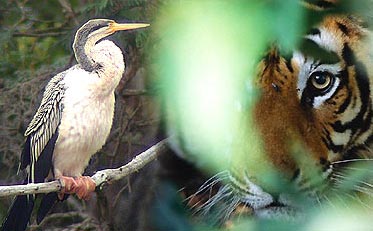 |
 |
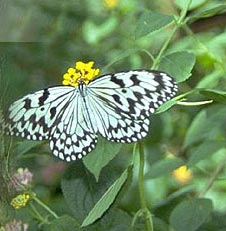 |
||
|
||||
Habitats & Bird Species
The bird habitats of the Indian subcontinent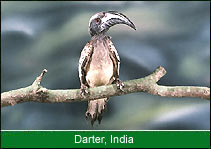 can
be roughly divided into forest, scrub, wetlands (inland and littoral), marine,
grassland, desert, and agricultural land. There is some overlap between habitats:
for example, mangrove forest can also be considered as wetland, as can seasonally
flooded grassland. Many bird species require mixed habitat types.
can
be roughly divided into forest, scrub, wetlands (inland and littoral), marine,
grassland, desert, and agricultural land. There is some overlap between habitats:
for example, mangrove forest can also be considered as wetland, as can seasonally
flooded grassland. Many bird species require mixed habitat types.
Forests
There is a great variety of forest types in the region. Tropical forest ranges from coastal mangroves to wet, dense evergreen forest, dry deciduous forest and open-desert thorn forest. In the Himalayas, temperate forest includes habitats of mixed broadleaves, moist oak and rhododendron, and dry coniferous forest of pines and firs; higher up, subalpine forest of birch, rhododendron and juniper occurs.
The forest areas of the region are vitally important for many of its birds. Over half of the bird species in the subcontinent identified by Birdlife International as globally threatened and two-thirds of the region's endemic birds are dependent on forest.
Primary tropical and subtropical broad leaved evergreen forest supports
the greatest diversity of bird species. Significant areas of these forest habitats
still remain in the eastern Himalayas and adjacent hills of northeast India,
in the Western Ghats, in the Andaman and Nicobar Islands, and in Sri lanka.
They also contain a higher number of endemic and globally threatened species
than any other habitat in the region.
supports
the greatest diversity of bird species. Significant areas of these forest habitats
still remain in the eastern Himalayas and adjacent hills of northeast India,
in the Western Ghats, in the Andaman and Nicobar Islands, and in Sri lanka.
They also contain a higher number of endemic and globally threatened species
than any other habitat in the region.
Tropical deciduous forest, including moist and dry sal and teak forest, riverine forest and dry thorn forest, once covered much of the plains and lower hills of the subcontinent. Several widespread endemic species are chiefly confined to these habitats, including Plum-headed Parakeet Psittacula cyanocephala.
Temperate and subalpine forest grows in the Himalayas. These forest types support a relatively high proportion of species with restricted distributions, notably White-throated Tit Aegithalos niveogularis.
Scrub
Scrub has developed in the region where trees are unable to grow, either because soils are poor and thin, or because they are too wet, as at the edges of wetlands or in seasonally inundated floodplains. Scrub also grows naturally in extreme climatic conditions, as in semidesert or at high altitudes in the Himalayas. In addition, there are now large areas of scrubland in the region where forest has been overexploited for fodder and fuel collection or grazing.
Relatively few birds in the subcontinent are characteristic of scrub habitats alone, but many are found in scrub mixed with grassland, in wetlands or at forest edges.
Wetlands
Wetlands are abundant in the region and support a rich array of waterfowl. As well as providing habitats for breeding resident species, they include major staging and wintering grounds for waterfowl breeding in central and northern Asia. The region possesses a wide range of wetland types, distributed almost throughout, including mountain glacial lakes, freshwater and brackish marshes, large water-storage reservoirs, village tanks, saline flats and coastal mangroves and mudflats. A total of 33 of the subcontinent's wetland bird species is globally threatened, including Spot-billed Pelican Pelecanus philippensis.
The subcontinent's most important wetland sites include Chilika lake, a brackish lagoon in Orissa on the east Indian coast; wetlands in the Indus valley in Pakistan; the Sunderbans in the Ganges-Brahmaputra delta in Bangladesh and India; the extensive seasonally flooded man-made lagoons of Keoladeo Ghana National Park; the vast saline flats of the Ranns of Kutch in northwest India; wetlands in the moist tropical and subtropical forest of Assam and Arunachal Pradesh; the marshes, jheels and terai swamps of the Gangetic plain; Point Calimere and Pulicat lake on India's east coast; the Haor basin of Sylhet and east Mymensingh in northeast Bangladesh; and the Brahmaputra floodplain in the Assam lowlands. Small water-storage reservoirs or tanks are a distinctive feature in India and provide important feeding and nesting areas for a wide range of waterbirds in some places, for example on the Deccan plateau.
Grasslands
The most important grasslands for birds in the subcontinent are theseasonally flooded grassland occurring across the Himalayan foothills and in the floodplains of the Indus and Brahmaputra rivers, the arid grassland of the Thar desert, and grasslands in peninsular India, especially those in Madhya Pradesh, Maharashtra and Karnataka. These lowland grasslands support distinctive bird communities, with a number of specialist endemic species. Most of the region's endemic grassland birds are seriously at risk including lesser Florican Sypheotides indica, Indian Bustard Ardeotis nigriceps, Bristled Grassbird Chaetornis striatus and Finn's Weaver Ploceus megarhynchus.
Desert
The Thar desert isthe largest desert in the region, covering an area of 200,000 km2 in northwest India and Pakistan. There are other extensive arid areas in Pakistan: the hot deserts of the Chagai, a vast plain west of the main mountain ranges of Baluchistan, and the Thai, Cholistan and Sibi deserts in central and eastern Pakistan. The far northern mountain regions, which the monsoon winds do not penetrate, experience a cold-desert climate. There is only one bird species, Stoliczka's Bushchat Saxicola macrorhyncha, which is virtually endemic to the region.
Seas
As a result of increased watching by dedicated observers, several seabirds have been added to the region's avifauna in recent years, notably the threatened Barau's Petrel Pterodroma baraui, which was first described for science only in 1963. Seabird breeding colonies in the subcontinent are concentrated chiefly in the Maldives and Lakshadweep.
Migration
The large majority (1006) of the 1300 or so species recorded in the region are resident,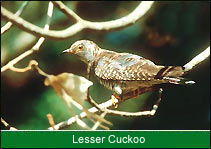 although
the numbers of some of these are augmented by winter visitors breeding farther
north. Some residents are sedentary throughout the year, while others undertake
irregular movements, either locally or more widely within the region, depending
on water conditions or food supply. Many Himalayan residents are altitudinal
migrants, the level to which they descend in winter frequently depending on
weather conditions; for instance, the Grandala summers at up to 5500 m and winters
chiefly down to 3000 m, but it has been recorded as low as 1950 m in bad weather.
A number of other residents in the subcontinent breed in the Himalayas and winter
farther south in the region, one example being the endemic Pied Thrush Zoothera
wardii, which spends the winter in Sri Lanka.
although
the numbers of some of these are augmented by winter visitors breeding farther
north. Some residents are sedentary throughout the year, while others undertake
irregular movements, either locally or more widely within the region, depending
on water conditions or food supply. Many Himalayan residents are altitudinal
migrants, the level to which they descend in winter frequently depending on
weather conditions; for instance, the Grandala summers at up to 5500 m and winters
chiefly down to 3000 m, but it has been recorded as low as 1950 m in bad weather.
A number of other residents in the subcontinent breed in the Himalayas and winter
farther south in the region, one example being the endemic Pied Thrush Zoothera
wardii, which spends the winter in Sri Lanka.
Eighteen species are exclusively summer visitors to the region. Most of these, such as Lesser Cuckoo Cucu/us po/iocepha/us, winter in Africa. Several species breed chiefly to the north and west of the subcontinent and extend just into Pakistan and northwest India, (or instance European Bee-eater Merops apiaster. Some species move southeastwards, perhaps as far as Malaysia and Indonesia; White-throated Needletail Hirundapus caudacutus is one example.
The subcontinent attracts 159 winter visitors, some of which are also passage migrants. There is also a small number of species (19) which are known only as passage migrants. The winter visitors originate mostly in northern and central Asia.
Information on migration routes in the region is still patchy, but it is believed that many of the subcontinent's winter visitors come through Pakistan, mainly en route to India and Sri Lanka. Ringing recoveries have shown that many winter visitors enter the subcontinent via the Indus plains. There is less information about migration routes in the northeast of the region, but the Brahmaputra river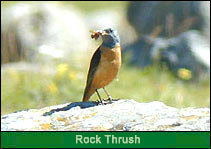 and its tributaries are thought to form a flyway for birds from northeast Asia.
Increasing evidence suggests that some birds breeding in the Palearctic, mainly
non-passerines, migrate directly across the Himalayas to winter in the subcontinent.
Other birds follow the main valleys, such as those of the Kali Gandaki, Dudh
Kosi and Arun in Nepal. Birds of prey, especially Aquila eagles, have also been
found to use the Himalayas as an east-west pathway in autumn; the wintering
area of these birds is unknown. Spotwinged Starling Sarog/ossa spiloptera also
undertakes east-wesmovements along the Himalayas, and it is possible that other
species perform similar migrations.
and its tributaries are thought to form a flyway for birds from northeast Asia.
Increasing evidence suggests that some birds breeding in the Palearctic, mainly
non-passerines, migrate directly across the Himalayas to winter in the subcontinent.
Other birds follow the main valleys, such as those of the Kali Gandaki, Dudh
Kosi and Arun in Nepal. Birds of prey, especially Aquila eagles, have also been
found to use the Himalayas as an east-west pathway in autumn; the wintering
area of these birds is unknown. Spotwinged Starling Sarog/ossa spiloptera also
undertakes east-wesmovements along the Himalayas, and it is possible that other
species perform similar migrations.
A number of pelagic and coastal passage migrants and wintering species travel by oceanic or coastal routes. One identified coastal flyway lies on India's east coast, linking Point Calimere in Tamil Nadu with Chilika and Pulicat Lakes. Migration patterns of seabirds are particularly poorly understood, but there is now evidence that some species occur more regularly than previously thought, especially around the time of the southwest monsoon. A few species that breed outside the region and winter in East Africa migrate through Pakistan and northwest India, for example Rufous-tailed Rock Thrush Montico/a saxatilis. As they occur mainly on autumn passage, they presumably use a different route in spring.
In addition to the subcontinnt's residents, summer and winter visitors and passage migrants, nearly 100 species of vagrant have been recorded.
The bird habitats of the Indian subcontinent
 can
be roughly divided into forest, scrub, wetlands (inland and littoral), marine,
grassland, desert, and agricultural land. There is some overlap between habitats:
for example, mangrove forest can also be considered as wetland, as can seasonally
flooded grassland. Many bird species require mixed habitat types.
can
be roughly divided into forest, scrub, wetlands (inland and littoral), marine,
grassland, desert, and agricultural land. There is some overlap between habitats:
for example, mangrove forest can also be considered as wetland, as can seasonally
flooded grassland. Many bird species require mixed habitat types.Forests
There is a great variety of forest types in the region. Tropical forest ranges from coastal mangroves to wet, dense evergreen forest, dry deciduous forest and open-desert thorn forest. In the Himalayas, temperate forest includes habitats of mixed broadleaves, moist oak and rhododendron, and dry coniferous forest of pines and firs; higher up, subalpine forest of birch, rhododendron and juniper occurs.
The forest areas of the region are vitally important for many of its birds. Over half of the bird species in the subcontinent identified by Birdlife International as globally threatened and two-thirds of the region's endemic birds are dependent on forest.
Primary tropical and subtropical broad leaved evergreen forest
 supports
the greatest diversity of bird species. Significant areas of these forest habitats
still remain in the eastern Himalayas and adjacent hills of northeast India,
in the Western Ghats, in the Andaman and Nicobar Islands, and in Sri lanka.
They also contain a higher number of endemic and globally threatened species
than any other habitat in the region.
supports
the greatest diversity of bird species. Significant areas of these forest habitats
still remain in the eastern Himalayas and adjacent hills of northeast India,
in the Western Ghats, in the Andaman and Nicobar Islands, and in Sri lanka.
They also contain a higher number of endemic and globally threatened species
than any other habitat in the region.Tropical deciduous forest, including moist and dry sal and teak forest, riverine forest and dry thorn forest, once covered much of the plains and lower hills of the subcontinent. Several widespread endemic species are chiefly confined to these habitats, including Plum-headed Parakeet Psittacula cyanocephala.
Temperate and subalpine forest grows in the Himalayas. These forest types support a relatively high proportion of species with restricted distributions, notably White-throated Tit Aegithalos niveogularis.
Scrub

Scrub has developed in the region where trees are unable to grow, either because soils are poor and thin, or because they are too wet, as at the edges of wetlands or in seasonally inundated floodplains. Scrub also grows naturally in extreme climatic conditions, as in semidesert or at high altitudes in the Himalayas. In addition, there are now large areas of scrubland in the region where forest has been overexploited for fodder and fuel collection or grazing.
Relatively few birds in the subcontinent are characteristic of scrub habitats alone, but many are found in scrub mixed with grassland, in wetlands or at forest edges.
Wetlands
Wetlands are abundant in the region and support a rich array of waterfowl. As well as providing habitats for breeding resident species, they include major staging and wintering grounds for waterfowl breeding in central and northern Asia. The region possesses a wide range of wetland types, distributed almost throughout, including mountain glacial lakes, freshwater and brackish marshes, large water-storage reservoirs, village tanks, saline flats and coastal mangroves and mudflats. A total of 33 of the subcontinent's wetland bird species is globally threatened, including Spot-billed Pelican Pelecanus philippensis.

The subcontinent's most important wetland sites include Chilika lake, a brackish lagoon in Orissa on the east Indian coast; wetlands in the Indus valley in Pakistan; the Sunderbans in the Ganges-Brahmaputra delta in Bangladesh and India; the extensive seasonally flooded man-made lagoons of Keoladeo Ghana National Park; the vast saline flats of the Ranns of Kutch in northwest India; wetlands in the moist tropical and subtropical forest of Assam and Arunachal Pradesh; the marshes, jheels and terai swamps of the Gangetic plain; Point Calimere and Pulicat lake on India's east coast; the Haor basin of Sylhet and east Mymensingh in northeast Bangladesh; and the Brahmaputra floodplain in the Assam lowlands. Small water-storage reservoirs or tanks are a distinctive feature in India and provide important feeding and nesting areas for a wide range of waterbirds in some places, for example on the Deccan plateau.
Grasslands
The most important grasslands for birds in the subcontinent are theseasonally flooded grassland occurring across the Himalayan foothills and in the floodplains of the Indus and Brahmaputra rivers, the arid grassland of the Thar desert, and grasslands in peninsular India, especially those in Madhya Pradesh, Maharashtra and Karnataka. These lowland grasslands support distinctive bird communities, with a number of specialist endemic species. Most of the region's endemic grassland birds are seriously at risk including lesser Florican Sypheotides indica, Indian Bustard Ardeotis nigriceps, Bristled Grassbird Chaetornis striatus and Finn's Weaver Ploceus megarhynchus.
Desert

The Thar desert isthe largest desert in the region, covering an area of 200,000 km2 in northwest India and Pakistan. There are other extensive arid areas in Pakistan: the hot deserts of the Chagai, a vast plain west of the main mountain ranges of Baluchistan, and the Thai, Cholistan and Sibi deserts in central and eastern Pakistan. The far northern mountain regions, which the monsoon winds do not penetrate, experience a cold-desert climate. There is only one bird species, Stoliczka's Bushchat Saxicola macrorhyncha, which is virtually endemic to the region.
Seas
As a result of increased watching by dedicated observers, several seabirds have been added to the region's avifauna in recent years, notably the threatened Barau's Petrel Pterodroma baraui, which was first described for science only in 1963. Seabird breeding colonies in the subcontinent are concentrated chiefly in the Maldives and Lakshadweep.
The large majority (1006) of the 1300 or so species recorded in the region are resident,
 although
the numbers of some of these are augmented by winter visitors breeding farther
north. Some residents are sedentary throughout the year, while others undertake
irregular movements, either locally or more widely within the region, depending
on water conditions or food supply. Many Himalayan residents are altitudinal
migrants, the level to which they descend in winter frequently depending on
weather conditions; for instance, the Grandala summers at up to 5500 m and winters
chiefly down to 3000 m, but it has been recorded as low as 1950 m in bad weather.
A number of other residents in the subcontinent breed in the Himalayas and winter
farther south in the region, one example being the endemic Pied Thrush Zoothera
wardii, which spends the winter in Sri Lanka.
although
the numbers of some of these are augmented by winter visitors breeding farther
north. Some residents are sedentary throughout the year, while others undertake
irregular movements, either locally or more widely within the region, depending
on water conditions or food supply. Many Himalayan residents are altitudinal
migrants, the level to which they descend in winter frequently depending on
weather conditions; for instance, the Grandala summers at up to 5500 m and winters
chiefly down to 3000 m, but it has been recorded as low as 1950 m in bad weather.
A number of other residents in the subcontinent breed in the Himalayas and winter
farther south in the region, one example being the endemic Pied Thrush Zoothera
wardii, which spends the winter in Sri Lanka.Eighteen species are exclusively summer visitors to the region. Most of these, such as Lesser Cuckoo Cucu/us po/iocepha/us, winter in Africa. Several species breed chiefly to the north and west of the subcontinent and extend just into Pakistan and northwest India, (or instance European Bee-eater Merops apiaster. Some species move southeastwards, perhaps as far as Malaysia and Indonesia; White-throated Needletail Hirundapus caudacutus is one example.
The subcontinent attracts 159 winter visitors, some of which are also passage migrants. There is also a small number of species (19) which are known only as passage migrants. The winter visitors originate mostly in northern and central Asia.
Information on migration routes in the region is still patchy, but it is believed that many of the subcontinent's winter visitors come through Pakistan, mainly en route to India and Sri Lanka. Ringing recoveries have shown that many winter visitors enter the subcontinent via the Indus plains. There is less information about migration routes in the northeast of the region, but the Brahmaputra river
 and its tributaries are thought to form a flyway for birds from northeast Asia.
Increasing evidence suggests that some birds breeding in the Palearctic, mainly
non-passerines, migrate directly across the Himalayas to winter in the subcontinent.
Other birds follow the main valleys, such as those of the Kali Gandaki, Dudh
Kosi and Arun in Nepal. Birds of prey, especially Aquila eagles, have also been
found to use the Himalayas as an east-west pathway in autumn; the wintering
area of these birds is unknown. Spotwinged Starling Sarog/ossa spiloptera also
undertakes east-wesmovements along the Himalayas, and it is possible that other
species perform similar migrations.
and its tributaries are thought to form a flyway for birds from northeast Asia.
Increasing evidence suggests that some birds breeding in the Palearctic, mainly
non-passerines, migrate directly across the Himalayas to winter in the subcontinent.
Other birds follow the main valleys, such as those of the Kali Gandaki, Dudh
Kosi and Arun in Nepal. Birds of prey, especially Aquila eagles, have also been
found to use the Himalayas as an east-west pathway in autumn; the wintering
area of these birds is unknown. Spotwinged Starling Sarog/ossa spiloptera also
undertakes east-wesmovements along the Himalayas, and it is possible that other
species perform similar migrations.A number of pelagic and coastal passage migrants and wintering species travel by oceanic or coastal routes. One identified coastal flyway lies on India's east coast, linking Point Calimere in Tamil Nadu with Chilika and Pulicat Lakes. Migration patterns of seabirds are particularly poorly understood, but there is now evidence that some species occur more regularly than previously thought, especially around the time of the southwest monsoon. A few species that breed outside the region and winter in East Africa migrate through Pakistan and northwest India, for example Rufous-tailed Rock Thrush Montico/a saxatilis. As they occur mainly on autumn passage, they presumably use a different route in spring.
In addition to the subcontinnt's residents, summer and winter visitors and passage migrants, nearly 100 species of vagrant have been recorded.
Indian Birding
Birding in India Birding Tours India
Birding Tours India  Bird Watching India
Bird Watching India  India Bird Checklist
India Bird Checklist  Habitat & Bird Species
Habitat & Bird Species
Bird Conservation
Birding in India
Bird Conservation
| Home | About Us | FAQ's | Contact Us | Commendations | Reservation |
| Copyright © Wildlife India Plus ( All Rights Reserved. ) | Web Development & SEO Services by |

